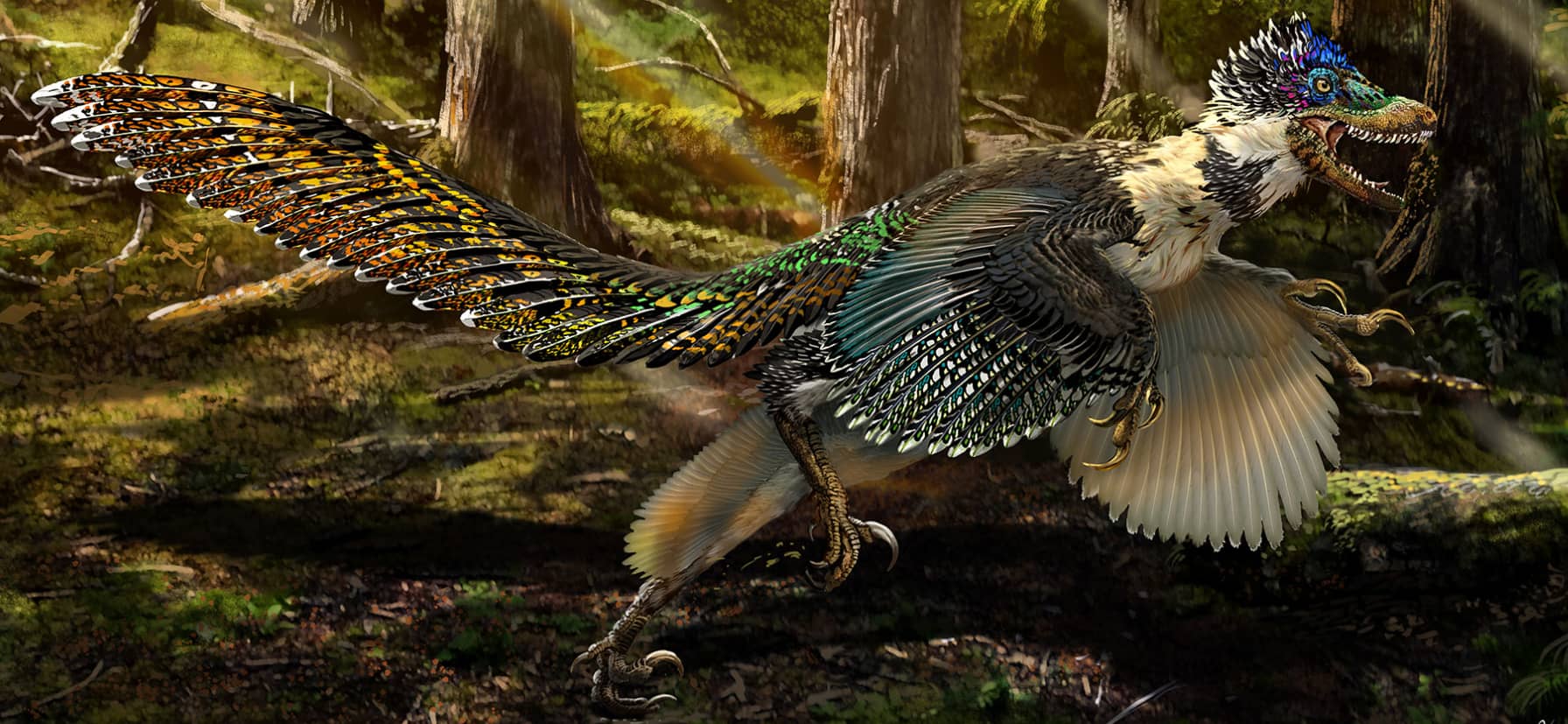Yes, birds are the direct descendants of theropod dinosaurs, such as T. rex, that roamed planet earth over 100 million years ago. Chickens, turkeys, hummingbirds – all birds, in fact – are literally modern-day dinosaurs. Dinosaurs first evolved bird-like characteristics during the Jurassic around 165–150 million years ago. Microraptor, for example, was an early flying dinosaur with four wings and vaned feathers. This flying dinosaur predated Archaeopteryx, once thought to be the earliest bird, by many millions of years.
By the 1990s most paleontologists accepted the dinosaur–bird link, but some ornithologists remained skeptical. This changed in the late-1990s when thousands of dinosaur fossils were unearthed in China, and it was evident that they had been covered in feathers. Fossils such as Microraptor and Deinonychus provided definitive visual evidence for the dinosaur–bird link, convincing even the most ardent of skeptics.
Birds evolved from dinosaurs, and therefore they are dinosaurs, in the same way that humans are mammals.
How do We Know that Birds Are Dinosaurs?
The origin of birds is now one of the best understood major transitions in the history of life.
Scientific knowledge of birds and other creatures is constantly changing as new fossils are unearthed. The story of birds is unfolding through a combination of data from fossils, living species, and numerical analyses that show how birds developed entirely new body plans and behaviors over hundreds of millions of years of evolution.
It is now widely accepted that birds evolved from dinosaurs, with the two groups linked by hundreds of shared features. These include features of the skeleton, soft tissues, growth, reproduction, and behavior.
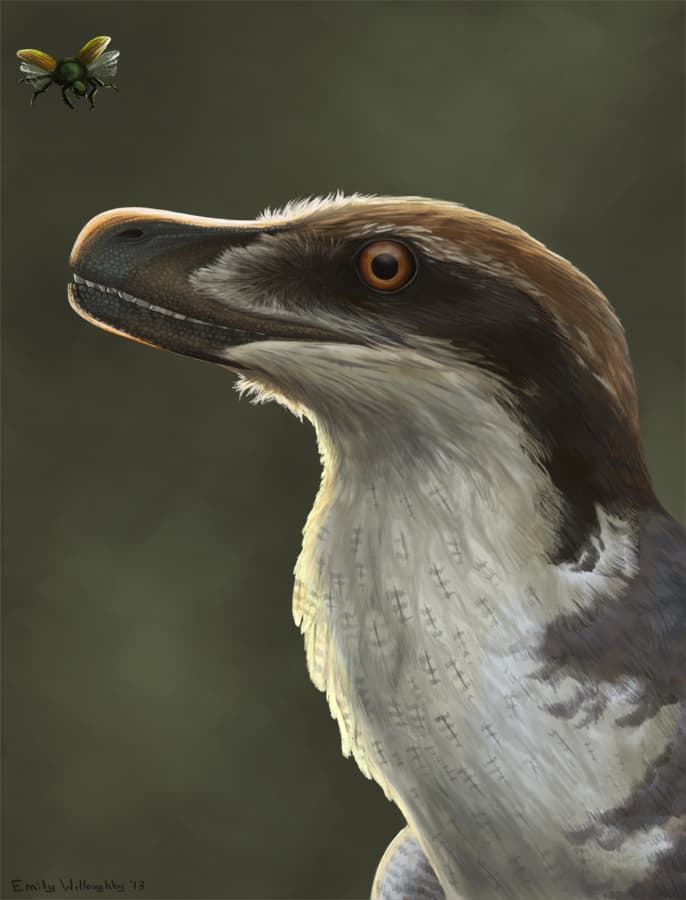
Hell Creek dromaeosaur described by Evans et al. November 2013.
Illustration by Emily Willoughby Wikimedia CCX3
Paleontologists refer to this new appreciation of the dinosaur/bird connection as the Dinosaur Renaissance
One of the most amazing discoveries is the fact that even many of the non-avian dinosaurs were feathered and would have looked more like birds than lizards or crocodiles.
See Feathered Dinosaurs in Action
For some amazing computer-generated images of dinosaurs with feathers, check out this short video preview for Prehistoric Planet with David Attenborough. These are some of the most compelling scenes showing feathered dinosaurs that I’ve come across, and they’re based on the latest scientific understanding.
Bird-like Characteristics Evolved over Millions of Years
Key bird-like characteristics, such as wings and feathers, evolved over a period of roughly 100 million years.
The transition from dinosaur to bird was not a linear step like series of events. In the evolutionary history of birds, the ability to fly, for example, evolved and disappeared several times. The common characteristics of modern birds, the bird ‘blueprint,’ was pieced together gradually over many tens of millions of years of evolution, not in one sudden transformative event.
It is amazing to realize how many of the features we see among living birds had already been developed more than 100 million years ago.
Early bird-like dinosaurs evolved steadily alongside their close dinosaur relatives until the non-avian dinosaurs went extinct 66 million years ago when a massive meteor crashed into planet earth. The K–Pg extinction event resulted in the sudden mass extinction of three-quarters of the plant and animal species on Earth, marking the end of the Cretaceous period.
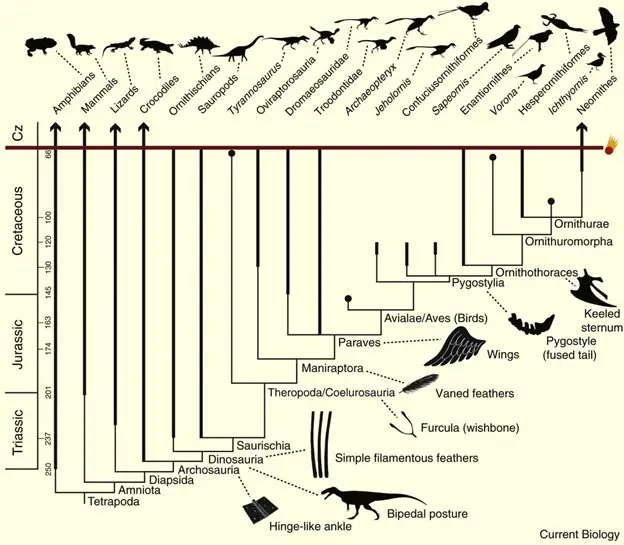
Common bird-like characteristics like the bipedal posture, hollow bones, and long S-shaped necks of birds were inherited from deep dinosaurian ancestors. The wishbone (furcula) and three-fingered hands of birds first appeared in primitive theropod dinosaurs.
Long-term evolutionary trends in the skeleton and musculature across dinosaurs and early birds led to two of the most characteristic features of living birds:
- the elongated arms, which became wings in birds, and
- the ‘crouched’ hindlimb posture that would have been novel at the time. In this posture the femur is held in a nearly horizontal position and most of the action in the hindlimb occurs at the knee joint rather than the pelvic joint.
The closest relatives of birds are mostly small-bodied, feathered, large-brained dromaeosaurids and troodontids, exemplified by the well-known Velociraptor.
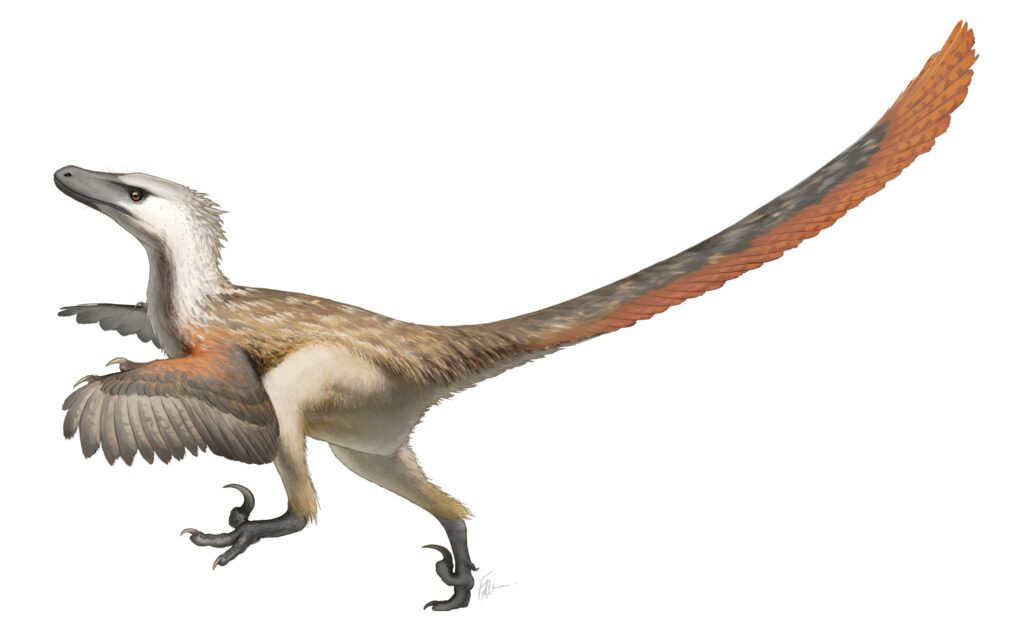
Credit: Fred Wierum on Wikimedia
How Did Bird Feathers Evolve?
Here’s an amazing fact: many dinosaurs had feathers!
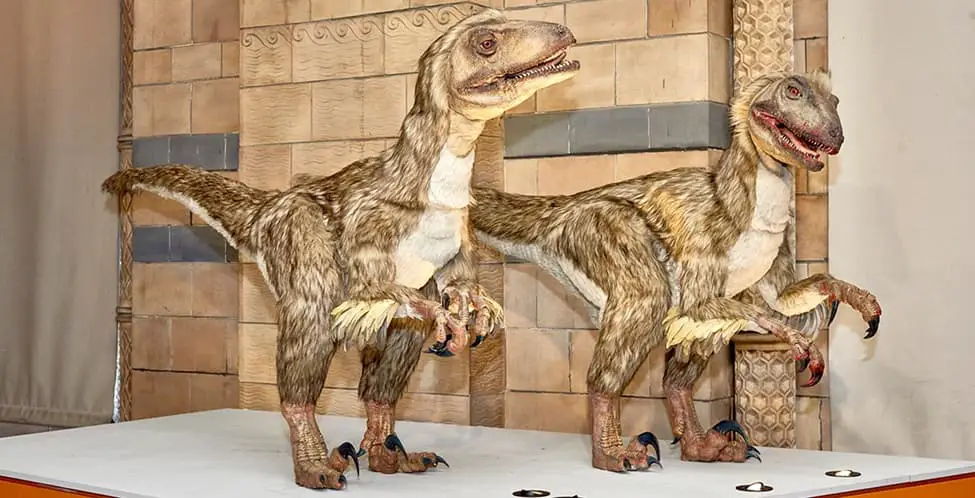
Perhaps the single most recognizable feature of birds is their feathers, used for flight, thermoregulation, egg brooding, and also for display.
The story of how feathers evolved is becoming increasingly clear: we now know that the earliest feathers evolved in non-flying dinosaurs, likely for sexual display (see my article on Sexual selection) and/or thermoregulation.
Eventually feathers became co-opted into flight structures in the earliest birds and their closest dinosaurian relatives.
The evolution of feathers likely began in the earliest dinosaurs, or perhaps even in the closest relatives of dinosaurs.
Simple, hair-like filaments called ‘protofeathers’ have been found on spectacularly well-preserved fossils of some primitive theropods, such as the tyrannosaurs Dilong and Yutyrannus, and plant-eating ornithischian dinosaurs. Some of these early dinosaurs were covered in these filaments, something like a downy coat.
These hair-like filaments are widely considered to represent the earliest stage of feather evolution. With further evolution these simple structures became more complex. The branching, vaned feathers of modern birds first occurred in maniraptoran theropod dinosaurs, roughly 175 million years ago.
In fact, some non-bird dinosaurs – the group that went extinct – like Microraptor, possessed feathers basically indistinguishable from the flight feathers of living birds!
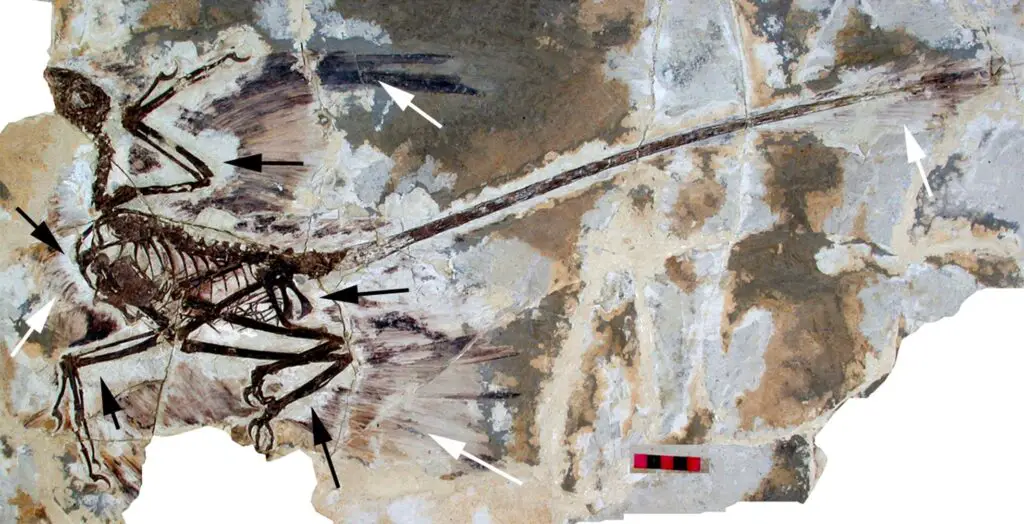
Furthermore, in many non-bird dinosaurs, vaned feathers were layered together to form wings on the arms, as well as the legs and tails. Scientists are still unsure whether these wings were capable of flight, or perhaps used for other functions, such as egg brooding or display.
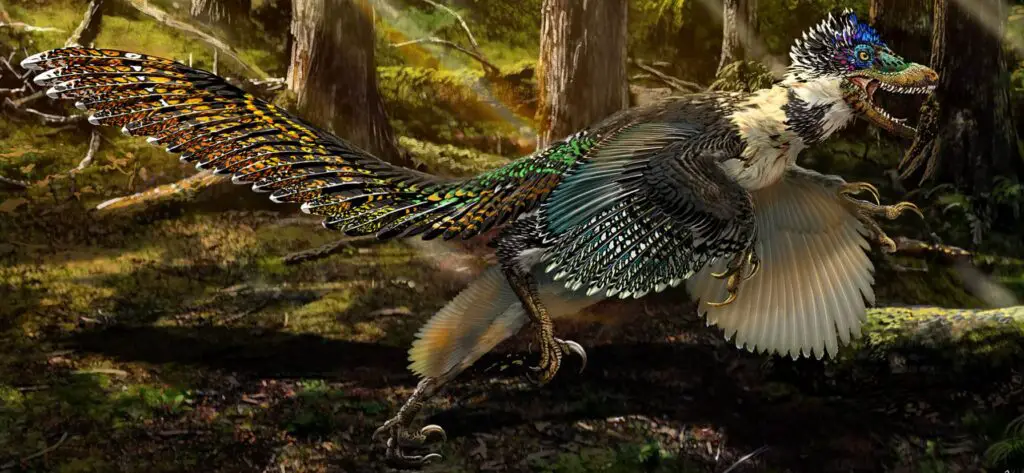
How did Birds Evolve the Ability to Fly?
To understand how birds evolved the ability to fly, many scientists believe that the following three main points provide the most likely explanation (based on current evidence).
1. First, much of the evolution of complex feathers and wings in non-bird dinosaurs was driven by factors other than flight, such as sexual display.
(Speaking of sexual display, see my article on Sexual Selection to see how factors such as colorful plumage and impressive dance moves can determine which individuals get to mate and thus, to pass on their genes. Sounds familiar, doesn’t it?)
2. Second, some early dinosaurs developed flight at roughly the same time as early birds.
Some dinosaurs had flight-related features such as large wings and asymmetrical feathers (such as Microraptor). These dinosaurs evolved the ability to fly during roughly the same period, in parallel to the development of flight among the birds.
Scientists are confident that flight probably evolved multiple times within maniraptoran dinosaurs, occasionally enabled by structures other than feathered wings. Take, for example, the fascinating Scansoriopterygidae, a bizarre creature that evolved gliding flight with fleshy membranes between the forelimbs and hind limbs.
One species of Scansoriopterygidae recently discovered in China, named Ambopteryx longibrachium, has a unique wing structure without flight feathers.
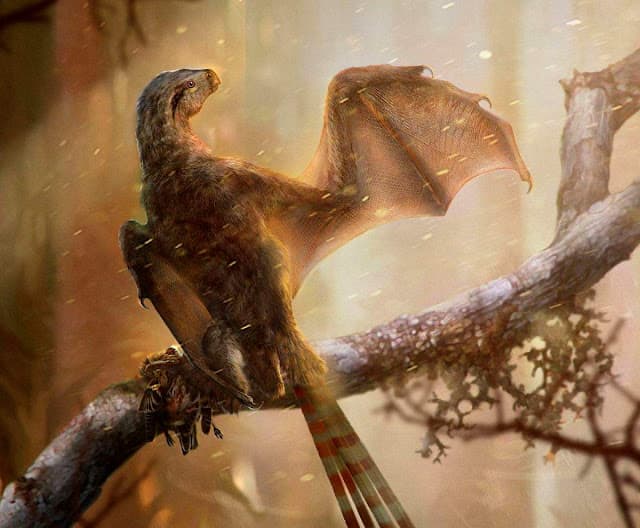
Unlike other flying dinosaurs, namely birds, A. longibrachi had leathery, membranous wings supported by a rod-like wrist bone not found in any other dinosaur (but is present in pterosaurs and flying squirrels).
3. Third, powered flight developed after the origin of birds
Although early birds and even some non-bird dinosaurs had flight capabilities, powered flight as we know it in modern birds most certainly developed after the origin of birds themselves.
It was millions of years after Archaeopteryx appeared that the modern style of powered avian flight developed. Specialized structures evolved such as a keeled sternum that could support relatively huge flight muscles, a specialized tail, and a triosseal canal in the shoulder which encloses a pulley-like system used in a bird’s upstroke.
These innovations were combined with earlier features, such as elongated, feathered forelimbs and narrow wishbones. The total package of specialized features enable modern birds to undertake the highly efficient, muscle-driven flight that allows some species to fly at altitudes of up to 9,000 meters (29,500 ft) (such as some vultures and geese) and over distances of hundreds and even thousands of kilometers (such as the record breaking Arctic Tern that flies 90,000 km (55,923 mi) from pole to pole every year).
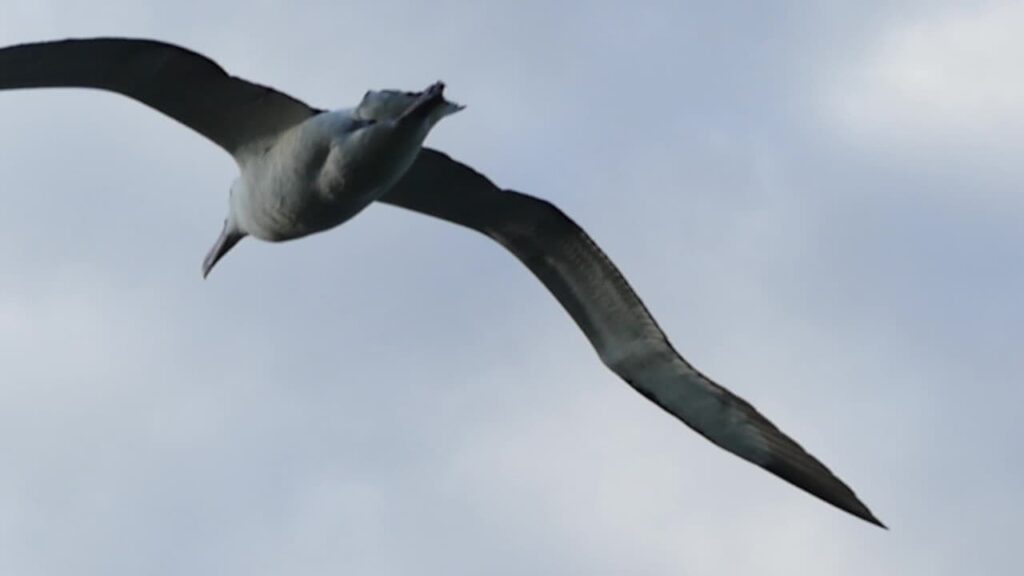
Interested in the amazing flight abilities of modern birds? Check out my article on the secrets of Albatross flight and how they can remain in the air for days without expending any muscular energy.
Why are Birds the Only Surviving Dinosaurs?
We know from an abundance of dinosaur fossils, teeth, tracks, and eggs that Earth was largely ruled by dinosaurs for at least 230 million years – up until 66 million years ago.
And then… BANG!! A massive meteor crashed into planet Earth and changed everything.
Not a single trace of dinosaur remains has been found in rocks younger than 66 million years. Non-avian dinosaurs suddenly disappeared.
Avian dinosaurs – birds – survived the mass extinction and are still with us here today. In fact, there are almost 10,000 species of bird on our planet – a remarkable success story!
Are we still living in the age of the dinosaur!? After all, there are twice as many species of birds as there are mammal species!
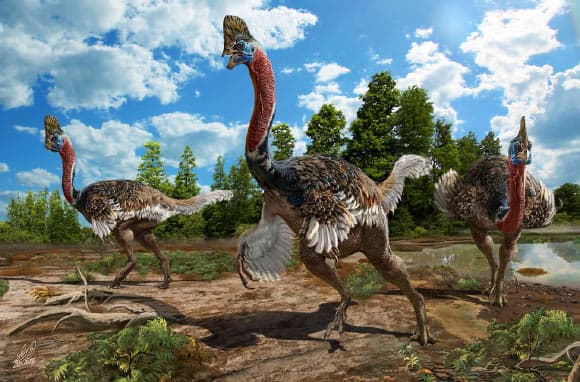
Credit Zhao Chuang
Meet a bird that looks like a dinosaur – the Cassowary!
If there’s one bird that could almost certainly erase any doubt that birds are living dinosaurs, it would be the cassowary. Look at the following photo – you would almost swear that you’re looking at a feathered dinosaur! (Read my article to learn more about the fascinating Cassowary and why it is considered the most dangerous bird in the world.)
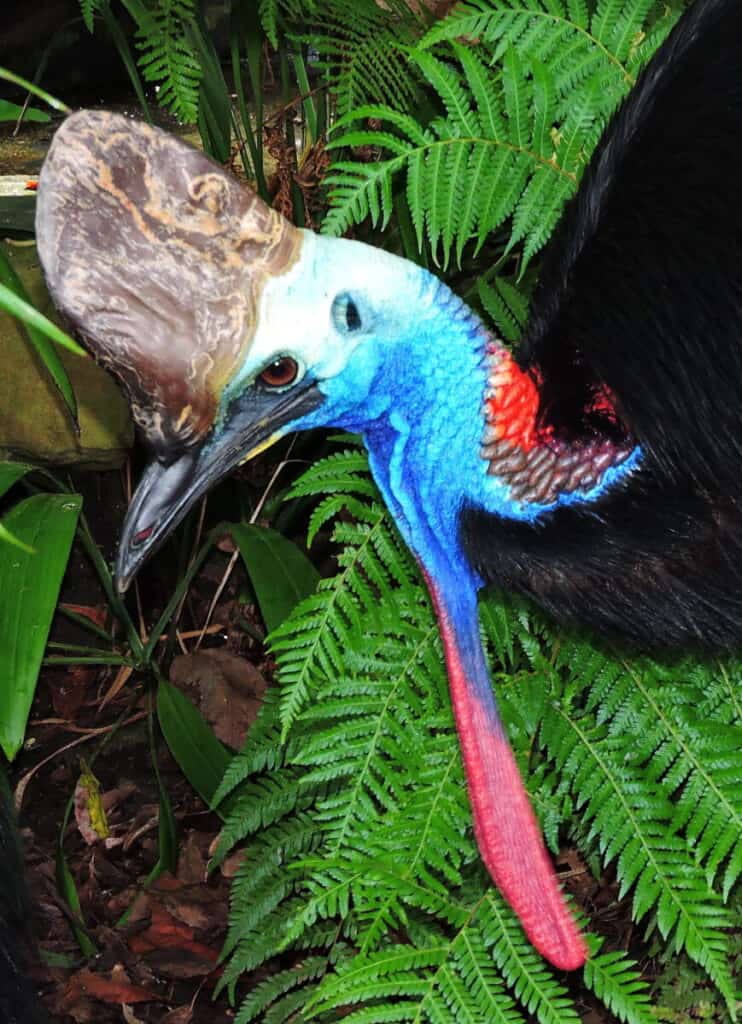

Excellent video by BBC Earth showing the strong connection between cassowaries and dinosaurs.
Here are three main ideas to explain how and why birds are the only surviving dinosaurs:
1. Most birds are small.
From the fossil evidence available today, it appears that the avian dinosaurs that survived the mass extinction were no bigger than modern-day ducks.
Small creatures tend to breed faster than larger animals. This means that, in general, they adapt more quickly to changing circumstances and environments.
It appears that birds were able to adapt to the extreme conditions caused by the massive asteroid impact more quickly than the larger animals could have. The skies would have become dark for years following the impact, halting photosynthesis in plants and largely obliterating most terrestrial ecosystems on earth. Ocean ecosystems faced similar obliteration with the end of photosynthesizing plankton and the acidification of oceans.
The relatively small size of early birds also gave them another advantage: they didn’t need to eat as much as large animals. This would have been handy considering how much more difficult it would have been to find food with the abrupt disruption to plants and animals that formed the basis of the food web.
2. Birds have adapted to almost every ecological niche available by becoming specialized feeders.
If there’s something edible, it’s pretty much a given that there’s a bird out there that’s ready and able to eat it!
This means that birds can eat many different things, including seeds, fruit, insects, fish, carrion, and even bones. This is largely due to their variety of beak shapes and feeding behaviors.
Biologists like to say that “form follows function,” meaning that the form of a body part or structure is related to its function. This is evident in the beak shapes of birds: seed-eating birds have robust beaks, predatory birds have sharp beaks and talons, and dabbling ducks have flat bills.
One particularly intriguing beak belongs to the flamingo – see my article on Flamingo beaks; designed to be used upside down while filter-feeding on microorganisms. What! Who would imagine a filter-feeding dinosaur (i.e., flamingo)!?
For another fascinating look at a specialized bird adaptation read my article on woodpecker tongues and how they wrap around the the outside of their skulls.
The form or shape of a structure within an organism is correlated with the purpose or function of that structure.
After the mass extinction there was much less competition for scarce resources, and birds began to specialize to fill the wide range of niches available so more and more beak shapes began to appear.
3. Most birds can fly, and they evolved the ability to fly many millions of years ago.
Flying takes less energy than walking or running to travel long distances.
Consequently, birds could easily escape habitats with poor resources, to explore new areas in the search for better food sources and safer places to live. This gave them an edge over terrestrial species that could cover long distances, but much more slowly.
Was Archaeopteryx a Bird or a Dinosaur?
Since Archaeopteryx displays features common to both birds and non-avian dinosaurs, it has often been considered a link between the two groups.
Archaeopteryx lived in the Late Jurassic around 150 million years ago and was roughly the size of a raven. It had broad, feathered wings that were rounded at the ends and a long reptilian tail compared to its body length. It could reach up to 500 millimetres (20 in) in body length, with an estimated mass of 0.8 to 1 kilogram (1.8 to 2.2 lb).
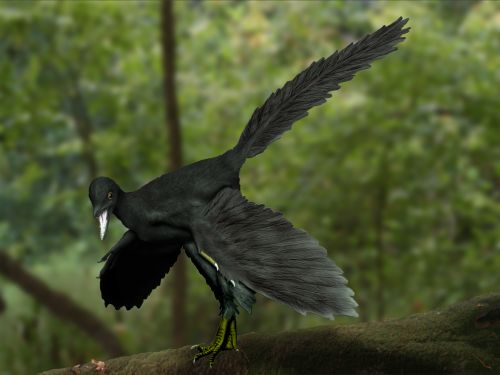
Credit Nobu Tamura CC BY-SA 3.0
Archaeopteryx had feathers and they were very similar in structure to those of modern-day birds. In addition to wings and feathers and numerous avian features, Archaeopteryx had many non-avian theropod dinosaur characteristics, such as small teeth, and a long bony tail, features which Archaeopteryx shared with other dinosaurs of the time. It is believed that Archaeopteryx could fly, but probably not in a sustained flight like many modern birds.
Let’s clear up a common misconception; Archaeopteryx is not the common ancestor of all living birds.
In fact, over the past 30 years scientific expeditions to China, Mongolia, South and North America, and elsewhere have uncovered dinosaurs that featured avian characteristics millions of years before Archaeopteryx arrived on the scene.
Archaeopteryx is one of the most important fossils ever discovered. It has become central to our understanding of evolution.
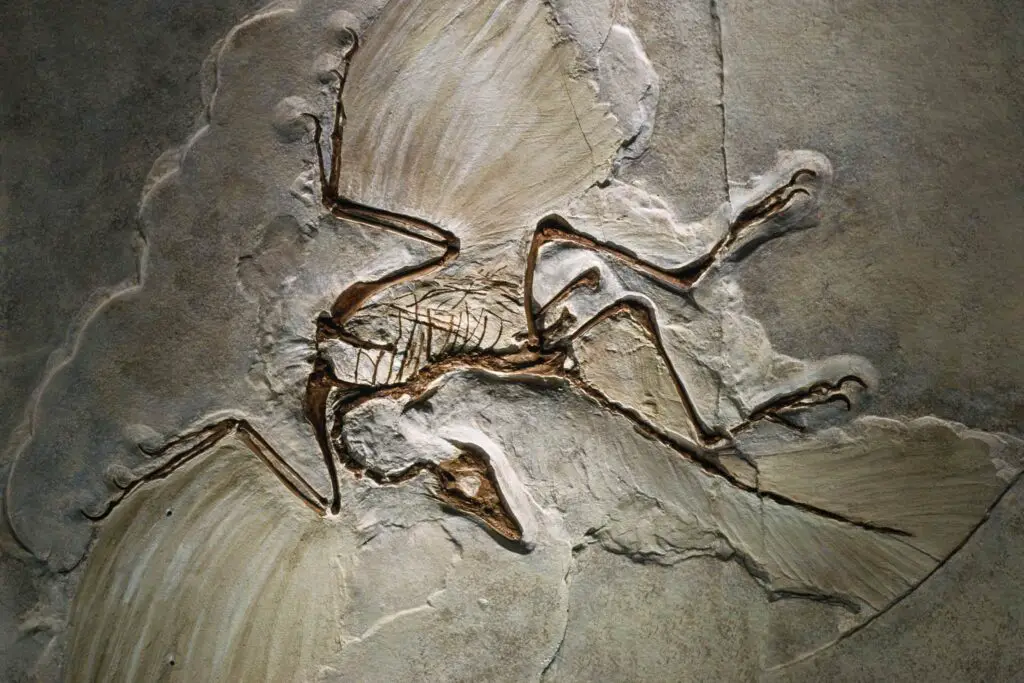
The first specimen of Archaeopteryx was discovered in 1861, shortly after the publication of Charles Darwin’s “On the Origin of Species by Means of Natural Selection.” This unusual fossil, dating back to the late Jurassic, became referred to as the ‘London specimen’ because it ended up in the London Natural History Museum. Since 1861, a total of twelve (and still counting) specimens of Archaeopteryx have been discovered.
These fossils provide beautiful examples of a “transitional form” between two vertebrate groups (reptiles and birds); just what Darwin expected would eventually be found (a so called “missing link” that is no longer missing.)
Archaeopteryx is intermediate between the birds that we see flying around today and predatory dinosaurs like Deinonychus.
It has long been accepted that Archaeopteryx was a transitional form between birds and reptiles, and long considered to be the earliest known bird. Lately, scientists have realized that it bears even a stronger resemblance to its ancestors, the Maniraptora, than to modern birds, providing a strong phylogenetic link between the two groups.
Archaeopteryx is sometimes referred to as Urvogel, the German word for “original bird” or “first bird.”
“The fact that scientists are having a difficult time distinguishing the earliest birds from their closest dinosaur relatives illustrates just how bird-like some non-bird dinosaurs were, and how the transition between non-bird dinosaurs and birds was gradual.”
Brusatte et al, 2015
Fast forward to 1969, when Dr. J.H. Ostrom described a therepod dinosaur, Deinonychus antirrhopus and noted its similarities to Archaeopteryx. This research represented a major step in convincing scientists worldwide of the theory that birds are the descendants of dinosaurs.
Dr. Ostrom’s work since the 1970’s has provided the impetus for a paradigm shift in paleontologists’ visions of the origin of birds and the evolution of flight. In addition, Dr. Gauthier’s work on clades in the mid-1980’s provided the best systematic analytical support for the theory. Independent analyses by several scientists since that time have repeatedly upheld Gauthier’s results.
Since we recognize that Archaeopteryx was indeed a dinosaur, what group of dinosaurs did it belong to?
Some researchers are proposing that the closest relatives of birds are Coelurosaurian dinosaurs (from Greek, meaning “hollow tailed lizards”). This is based on cladistic analyses of the skeletal morphology of these animals.
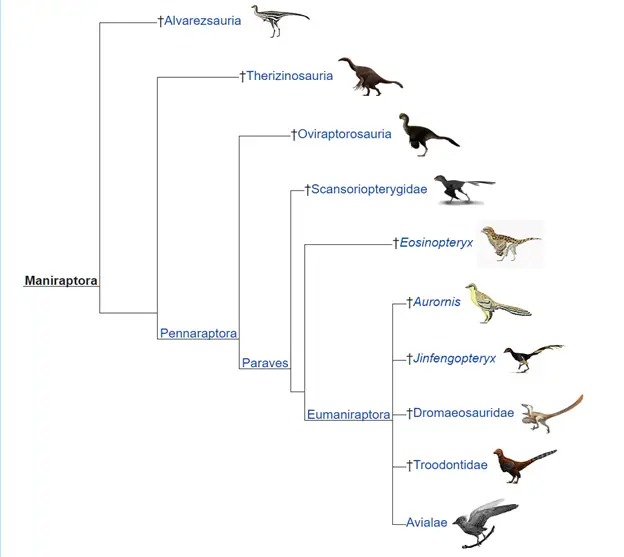
These days, paleontologists are agreed that birds are descended from coelurosaurs. In fact, birds are considered the only living lineage of coelurosaurs. Birds are classified by most paleontologists as belonging to the subgroup Maniraptora.
We can safely say that birds are, in fact, living dinosaurs!
Take a look at Dr. Jaques Gauthier’s informative and entertaining lecture – Birds are Living Dinosaurs
PS: If you thought dinosaurs might taste like chicken… you were right!! Now pass that dinosaur drumstick, please!
References
Brusatte SL, O’Connor JK, Jarvis ED (2015). The Origin and Diversification of Birds, Current Biology, Volume 25, Issue 19, 2015, ISSN 0960-9822, https://doi.org/10.1016/j.cub.2015.08.003.
Cau, Andrea; Brougham, Tom; Naish, Darren (2015). “The phylogenetic affinities of the bizarre Late Cretaceous Romanian theropod Balaur bondoc (Dinosauria, Maniraptora): Dromaeosaurid or flightless bird?”. PeerJ. 3: e1032. doi:10.7717/peerj.1032. PMC 4476167. PMID 26157616.
Evans, D. C., D. Larson, and P. J. Currie. 2013. A new dromaeosaurid (Dinosauria: Theropoda) with Asian Affinities from the latest Cretaceous of North America. Naturwissenschaften 100 (11): 1041-1049. Available online here.
Gauthier, Jacques A. (1984): A cladistic analysis of the higher systematic categories of the Diapsida. [PhD dissertation]. Available from University Microfilms International, Ann Arbor, #85-12825, vii + 564 pp.
Hone DWE, Tischlinger H, Xu X, Zhang F (2010) The Extent of the Preserved Feathers on the Four-Winged Dinosaur Microraptor gui under Ultraviolet Light. PLoS ONE 5(2): e9223. doi:10.1371/journal.pone.0009223
Ostrom, JH., (1976) Archaeopteryx and the origin of birds. Biol. J. Linn. Sot. 8:91-182.
See Our TOP Articles for More Fascinating Creatures
- How do Snakes Mate? (Snake Reproduction Explained in Detail – with Videos and Diagrams)
- Are Birds Dinosaurs? Latest Science (How Birds Evolved from Dinosaurs)
- How do Octopus Reproduce? (Cannibalistic Sex, Detachable Penis)
- How Smart are Octopuses? Are Octopuses As Intelligent as Dogs?
- Do Jellyfish have Brains? How Can they Hunt without Brains?
- Why are Deep Sea Fish So Weird and Ugly? Warning: Scary Pictures!
- Are Komodo Dragons Dangerous? Where Can you See Them?
- Koala Brains – Why Being Dumb Can Be Smart (Natural Selection)
- How do Snakes Mate? (Snake Reproduction Explained in Detail – with Videos and Diagrams)
- Why do Lions Have Manes? (Do Dark Manes Mean More Sex?)
- How Do Lions Communicate? (Why Do Lions Roar?)
- How Dangerous are Stonefish? Can You Die if You Step on One?
- What Do Animals Do When They Hibernate? How do they Survive?
- Leaf Cutter Ants – Surprising Facts and Adaptations; Pictures and Videos
- Irukandji Jellyfish Facts and Adaptations; Can They Kill You? Are they spreading?
- How to See MORE Wildlife in the Amazon: 10 Practical Tips
- Is it Safe to go on Safari with Africa’s Top Predators and Most Dangerous Animals?
- What to Do if You Encounter a Bullet Ant? World’s Most Painful Stinging Insect!
- How Do Anglerfish Mate? Endless Sex or Die Trying!
- How Smart are Crocodiles? Can They Cooperate, Communicate…Use Tools?
- How Can We Save Our Oceans? With Marine Sanctuaries!
- Why Are Male Birds More Colorful? Ins and Outs of Sexual Selection Made Easy!
- Why is the Cassowary the Most Dangerous Bird in the World? 10 Facts
- How Do African Elephants Create Their Own Habitat?
- What is Killing Our Resident Orcas? Endangered Killer Whales
- Why are Animals of the Galapagos Islands Unique?
- Where Can You See Wild Lemurs in Madagascar? One of the Best Places
- Where Can You see Lyrebirds in the Wild? the Blue Mountains, Australia
- Keeping Mason Bees as Pets
- Why do Flamingos have Bent Beaks and Feed Upside Down?
- Why are Hippos so Aggressive? Why do they Kill People?)

